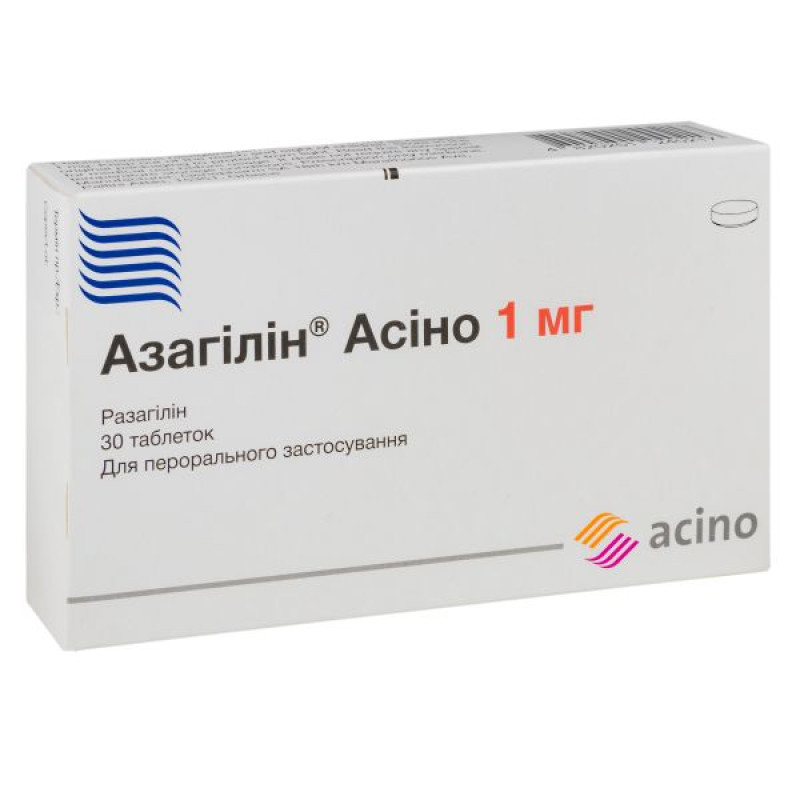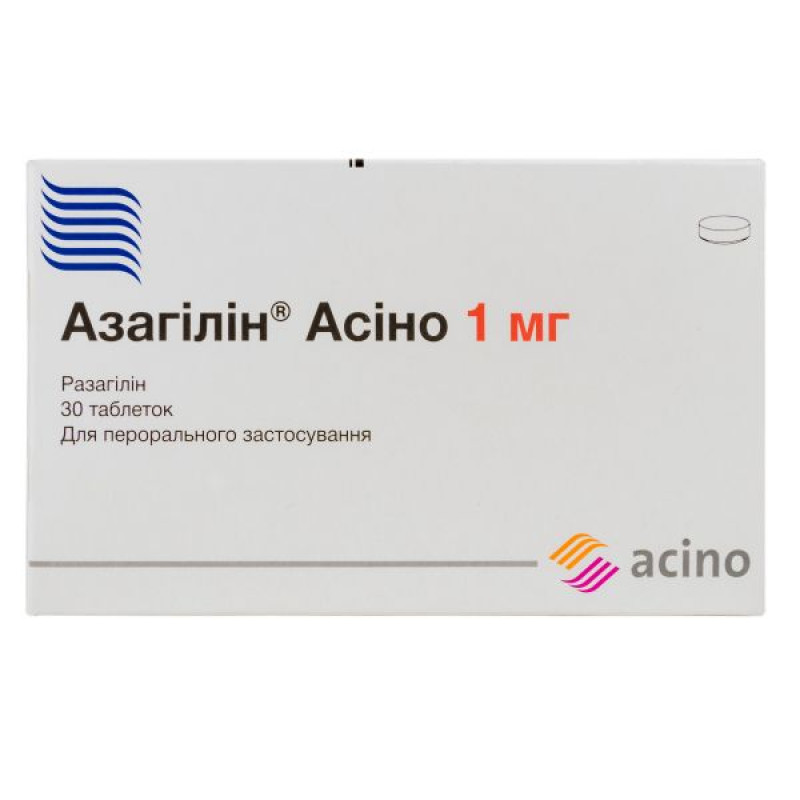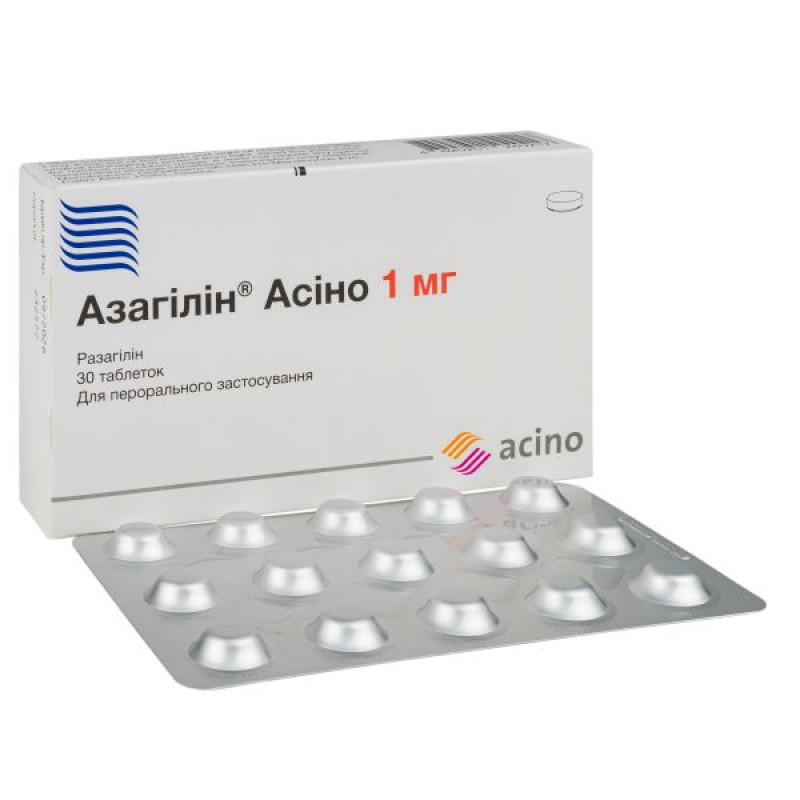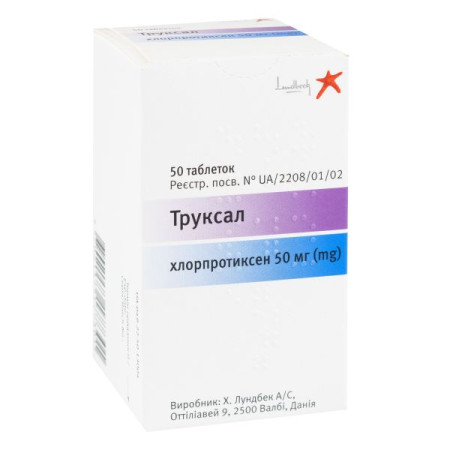Azagiline tablets 1 mg blister No. 30

Instructions Azagilin tablets 1 mg blister No. 30
Composition
active ingredient: rasagiline;
1 tablet contains 1.44 mg of rasagiline tartrate, which corresponds to 1 mg of rasagiline.
excipients: trehalose dihydrate, pregelatinized starch, colloidal anhydrous silicon dioxide, citric acid, talc, stearic acid, microcrystalline cellulose, croscarmellose sodium.
Dosage form
Pills.
Main physicochemical properties: round flat tablets of white or almost white color.
Pharmacotherapeutic group
Antiparkinsonian drugs. Monoamine oxidase inhibitors type B. ATX code N04B D02.
Pharmacological properties
Pharmacodynamics
Rasagiline is a potent and irreversible selective inhibitor of monoamine oxidase (MAO).
There are two main types of MAO – A and B. MAO-B is the type of MAO that is predominantly localized in the human brain.
In ex vivo studies on brain cells, liver and gastrointestinal tissues, rasagiline was found to be a potent, irreversible, selective inhibitor of monoamine oxidase type B (MAO-B).
The exact mechanism of action of rasagiline is unknown. It is believed that it is partly due to the drug's ability to block MAO-B. As a result, extracellular dopamine levels in the striatum increase and, as a result, dopaminergic activity is enhanced. This mechanism probably provides the therapeutic efficacy of rasagiline, which has been demonstrated in models of dopaminergic motor dysfunction.
Pharmacokinetics
Absorption. Rasagiline is rapidly absorbed, with peak plasma concentrations (Cmax) occurring approximately 0.5 hours after oral administration. The absolute bioavailability of rasagiline after a single dose is 36%. Food does not affect the time to peak plasma concentrations (Tmax), but Cmax and area under the concentration-time curve (AUC) are reduced by 60% and 20%, respectively, when administered with a fatty meal. Rasagiline can be taken without regard to meals.
Distribution: The mean volume of distribution after a single intravenous administration of rasagiline is 243 L. Plasma protein binding after a single oral dose of 14C-labeled rasagiline ranges from 60% to 70%.
Metabolism. Rasagiline is almost completely biotransformed in the liver. Metabolism occurs via two main pathways: N-dealkylation and/or hydroxylation to form the following metabolites: 1-aminoindan, 3-hydroxy-N-propargyl-1-aminoindan and 3-hydroxy-1-aminoindan. The main active metabolite of rasagiline is 1-aminoindan, which does not have the ability to inhibit MAO-B. In vitro studies have shown that both pathways of rasagiline metabolism involve the CYP1A2 isoenzyme of the cytochrome P450 system. The main route of elimination of rasagiline is via glucuronide conjugates and its metabolites.
Excretion: After oral administration of 14C-labeled rasagiline, its excretion is mainly in the urine (62.6%) and to a lesser extent in the feces (21.8%), the total elimination half-life of 84.4% of the dose is 38 days. Less than 1% of the drug is excreted in the urine as unchanged drug.
Linearity/non-linearity: Rasagiline exhibits linear pharmacokinetics over the 0.5-2 mg dose range. The elimination half-life is 0.6-2 hours.
Pharmacokinetics in certain patient groups.
Patients with liver failure.
In patients with mild hepatic impairment, Cmax and AUC were increased by 80% and 38%, respectively. In patients with moderate hepatic impairment, Cmax and AUC were increased by 568% and 83%, respectively.
Patients with renal impairment: The pharmacokinetic parameters of rasagiline are practically unchanged in patients with mild to moderate renal impairment.
Indication
Monotherapy for idiopathic parkinsonism;
adjuvant therapy with dopamine agonists;
adjuvant therapy with levodopa with a change in the final dose.
Contraindication
Hypersensitivity to the active substance or to any other component of the drug.
Concomitant therapy with other MAO inhibitors (including drugs and herbal preparations, such as those containing St. John's wort) or pethidine (the interval between discontinuation of rasagiline and the start of therapy with these drugs should be at least 14 days).
Severe liver failure.
Interaction with other medicinal products and other types of interactions
Interactions between non-selective MAO inhibitors and other drugs are known.
It is contraindicated to use rasagiline simultaneously with other MAO inhibitors (including drugs and herbal preparations containing St. John's wort) because there is a risk of non-selective inhibition of MAO, which may lead to the development of hypertensive crisis.
Interactions have been reported between MAO inhibitors and sympathomimetics when used concomitantly. Since rasagiline is a potent MAO inhibitor, its concomitant use with sympathomimetics, such as oral or nasal vasoconstrictors or cold preparations containing ephedrine or pseudoephedrine, is not recommended.
Interactions have been reported between dextromethorphan and non-selective MAO inhibitors when used concomitantly. Therefore, since rasagiline is a potent MAO inhibitor, its concomitant use with dextromethorphan is not recommended.
The concomitant use of rasagiline with fluoxetine and fluvoxamine should be avoided.
The interval between discontinuation of fluoxetine and initiation of rasagiline therapy should be at least 5 weeks. The interval between discontinuation of rasagiline and initiation of fluoxetine or fluvoxamine therapy should be at least 14 days.
Serious adverse reactions have been reported with the concomitant use of rasagiline with selective serotonin reuptake inhibitors (SSRIs), selective norepinephrine reuptake inhibitors (SNRIs), tricyclic/tetracyclic antidepressants and MAO inhibitors. Therefore, since rasagiline is a potent MAO inhibitor, caution should be exercised when rasagiline is used with antidepressants.
Levodopa, when co-administered with rasagiline in patients with Parkinson's disease, had no clinically significant effect on rasagiline clearance.
In vitro studies of rasagiline metabolism have shown that the cytochrome P450 isoenzyme CYP1A2 is the major enzyme responsible for rasagiline metabolism. Concomitant administration of rasagiline and ciprofloxacin (an inhibitor of CYP1A2) resulted in an 83% increase in rasagiline AUC. Concomitant administration of rasagiline and theophylline (a CYP1A2 isoenzyme) did not affect the pharmacokinetics of rasagiline. Therefore, potent CYP1A2 inhibitors may alter rasagiline plasma levels and should be used with caution.
There is a risk that due to induction of the CYP1A2 isoenzyme in smokers, the plasma concentration of rasagiline may decrease.
In vitro studies have shown that rasagiline at a concentration of 1 μg/ml (equivalent to a concentration 160 times higher than the mean Cmax (5.9-8.5 ng/ml) after multiple administration of 1 mg rasagiline to patients with Parkinson's disease) does not inhibit the cytochrome P450 isoenzymes CYP1A2, CYP2A6, CYP2C9, CYP2C19, CYP2D6, CYP2E1, CYP3A4 and CYP4A. Accordingly, rasagiline at therapeutic concentrations does not affect the metabolism of these isoenzymes and does not cause clinically significant effects.
When rasagiline and entacapone are administered orally, the clearance of rasagiline is increased by 28%.
Tyramine/rasagiline interactions.
The results of 5 clinical studies involving volunteers and patients with Parkinson's disease and the results of postprandial blood pressure control in these patients (464 patients used 0.5-1 mg/day of rasagiline or placebo as adjunctive therapy to levodopa for 6 months without restriction of tyramine intake) showed that there is no interaction between rasagiline and tyramine, therefore rasagiline can be used on a diet without restriction of tyramine intake.
Application features
The concomitant use of rasagiline and fluoxetine or fluvoxamine should be avoided (see section “Interaction with other medicinal products and other forms of interaction”). The interval between discontinuation of fluoxetine and initiation of rasagiline therapy should be at least 5 weeks. The interval between discontinuation of rasagiline and initiation of fluoxetine or fluvoxamine therapy should be at least 14 days.
Impulse control disorders may occur in patients taking dopamine agonists and/or receiving dopaminergic therapy. Similar cases of impulse control disorders have been reported with rasagiline in the post-marketing setting. Patients should be monitored for impulse control disorders. Patients and healthcare professionals should be made aware of behavioural changes suggestive of impulse control disorders that have been observed in patients taking rasagiline, including obsessions, compulsions, pathological gambling, increased libido, hypersexuality, impulsive behaviour, and compulsive spending or buying.
Rasagiline may potentiate the effects of levodopa, which may lead to increased adverse reactions to levodopa and exacerbation of existing dyskinesia. These adverse reactions may be reduced by reducing the dose of levodopa.
Cases of orthostatic hypotension have been reported with concomitant use of rasagiline and levodopa. Patients with Parkinson's disease are particularly vulnerable to adverse reactions of hypotension due to pre-existing gait problems.
In a study of rasagiline as monotherapy, hallucinations were reported in 1.3% of patients receiving 1 mg rasagiline and 0.7% of patients receiving placebo. In a study of concomitant use of rasagiline and dopamine agonists, hallucinations were reported in 1.2% of patients receiving 1 mg rasagiline and 1.8% of patients receiving placebo. In the rasagiline 1 mg/day and dopamine agonists group, 0.6% of patients discontinued the drug and prematurely withdrew from the study due to hallucinations, while no patients in the placebo group discontinued the drug or withdrew from the study due to hallucinations.
The concomitant use of rasagiline and dextromethorphan or sympathomimetics, such as those contained in nasal or oral vasoconstrictors or cold preparations containing ephedrine or pseudoephedrine, is not recommended (see section “Interaction with other medicinal products and other types of interactions”).
A retrospective cohort study suggests a possible increased risk of melanoma with rasagiline, particularly with long-term use and/or high cumulative doses of rasagiline. Any suspicious skin lesions should be evaluated by a specialist. Patients should be advised to seek advice from a dermatologist if any new or changing skin lesion occurs.
Rasagiline therapy should be initiated with caution in patients with mild hepatic impairment. Rasagiline should be avoided in patients with moderate hepatic impairment. Rasagiline should be discontinued in patients with progression of mild to moderate hepatic impairment.
Rasagiline may cause daytime drowsiness and sometimes, especially when used concomitantly with other dopaminergic agents, falling asleep during activities of daily living. Therefore, patients should be advised to exercise caution when driving or operating machinery while taking rasagiline. Patients who experience somnolence and/or episodes of sudden onset of somnolence while taking rasagiline should refrain from driving or operating machinery (see section 4.4).
Use during pregnancy or breastfeeding
There are no clinical data on the use of rasagiline in pregnant women. Animal studies do not indicate direct or indirect harmful effects on pregnancy, fetal development, parturition or the postpartum period. The drug should be prescribed with caution to pregnant women. There is evidence that rasagiline inhibits prolactin secretion and, as a result, suppresses lactation. It is not known whether rasagiline passes into breast milk. Rasagiline should be prescribed with caution during breastfeeding.
Ability to influence reaction speed when driving vehicles or other mechanisms
Rasagiline may affect the ability to drive or operate machinery.
Patients should be cautious when driving or operating machinery until they are certain that rasagiline does not have any harmful effects.
Patients treated with rasagiline who experience somnolence and/or sudden sleep onset episodes should be advised to refrain from driving or engaging in activities where impaired alertness may put themselves or others at risk of serious injury or death (e.g., operating machinery) until they have had sufficient experience with rasagiline and other dopaminergic agents to assess whether they are adversely affected by their mental and/or motor performance.
If increased drowsiness or additional episodes of sudden sleep onset during daily activities (e.g., watching TV, riding in a car, etc.) are observed at any time during treatment with rasagiline, patients should not drive or engage in potentially hazardous activities.
Patients should not drive, operate machinery, or perform work at heights during treatment if they have previously experienced sudden drowsiness and/or sudden sleep onset before taking rasagiline.
Patients should be warned about the possible potentiation of the effects of sedatives, alcohol or other central nervous system depressants (e.g. benzodiazepines, neuroleptics, antidepressants) when used in combination with rasagiline or when taking concomitant medications that increase rasagiline plasma levels (e.g. ciprofloxacin) (see section "Special warnings and precautions for use").
Method of administration and doses
Dosage regimen
Monotherapy
Rasagiline is administered orally at a dose of 1 mg once daily.
Adjuvant therapy with dopamine agonists
Rasagiline is administered orally at a dose of 1 mg once daily.
Adjuvant therapy with levodopa
The drug can be used regardless of meals.
Elderly patients.
No dose adjustment is required for elderly patients.
Patients with impaired liver function.
Rasagiline should be avoided in patients with moderate hepatic impairment and should be initiated with caution in patients with mild hepatic impairment. Rasagiline should be discontinued in patients with mild to moderate hepatic impairment.
Patients with renal impairment.
No dose adjustment is required for patients with renal impairment.
Children
Due to insufficient data on the use of the drug in children, rasagiline is not recommended for use in this category of patients.
Overdose
Symptoms of rasagiline overdose when using doses from 3 mg to 100 mg: hypomania, hypertensive crisis, serotonin syndrome.
Overdose may be associated with significant inhibition of MAO-A and MAO-B.
A single-dose study in healthy volunteers receiving 20 mg once daily and a 10-day study in healthy volunteers receiving 10 mg once daily were conducted. Mild to moderate adverse reactions were reported, which were related to the use of rasagiline and those not related to rasagiline treatment.
In a high-dose rasagiline study in patients receiving continuous levodopa and rasagiline 10 mg/day, cardiovascular adverse reactions (including hypertension and postural hypotension) were reported that resolved after treatment discontinuation.
These symptoms are similar to those observed with overdose of non-selective MAO inhibitors.
Specific treatment is unknown. In case of overdose, patients should be closely monitored and treatment should be symptomatic and supportive.
Side effects
Monotherapy
The following adverse reactions were reported with a higher frequency in placebo-controlled studies and in patients receiving 1 mg/day of rasagiline (number of patients receiving rasagiline – 149, placebo group – 151).
The following classification was used to assess the frequency of adverse reactions: very common (≥ 1/10), common (≥ 1/100 to < 1/10), uncommon (≥ 1/1000 to < 1/100), rare (≥ 1/10000 to < 1/1000), very rare (< 1/10000).
Infections and infestations: often - influenza.
Benign, malignant and unspecified neoplasms (including cysts and polyps): common – skin carcinoma.
From the side of the blood and lymphatic system: often - leukopenia.
On the part of the immune system: often - allergy.
Metabolism and nutrition disorders: infrequently - decreased appetite.
Mental disorders: often - depression, hallucinations.
From the nervous system: very often - headache; infrequently - cerebrovascular disorders.
From the organs of vision: often - conjunctivitis.
From the side of the organs of hearing and labyrinth: often - dizziness.
On the part of the heart: often - angina pectoris; infrequently - myocardial infarction.
Respiratory, thoracic and mediastinal disorders: often - rhinitis.
Gastrointestinal tract: often - flatulence.
Skin and subcutaneous tissue disorders: common: dermatitis; uncommon: vesiculobullous rash.
Musculoskeletal and connective tissue disorders: common: bone and muscle pain, neck pain, arthritis.
From the kidneys and urinary system: often - urge to urinate.
General disorders: often - fever, fatigue.
Adjuvant therapy with levodopa
The following adverse reactions were reported with a higher frequency in placebo-controlled studies and in patients receiving 1 mg/day of rasagiline (number of patients receiving rasagiline - 380, placebo group - 388).
The following classification was used to assess the frequency of adverse reactions: very common ≥ 1/10, common (≥ 1/100 to < 1/10), uncommon (≥ 1/1000 to < 1/100), rare (≥ 1/10000 to < 1/1000), very rare (< 1/10000).
Neoplasms benign, malignant and unspecified (including cysts and polyps): uncommon - cutaneous melanoma.
Metabolism and nutrition disorders: often - decreased appetite.
Mental disorders: often - hallucinations, abnormal dreams; infrequently - confusion.
From the nervous system: very often - dyskinesia; often - dystonia, carpal tunnel syndrome, balance disorders; infrequently - acute cerebrovascular accident.
Cardiac: infrequently - angina pectoris.
Vascular system: often - orthostatic hypotension.
Gastrointestinal: often - abdominal pain, constipation, nausea and vomiting, dry mouth.
Skin and subcutaneous tissue disorders: often - rash.
Musculoskeletal and connective tissue disorders: common: arthralgia, neck pain.
Investigations: common: weight loss.
Injuries and other complications: often accidental falls.
Adjuvant therapy with dopamine agonists
The following adverse reactions occurred in > 2% of patients treated with rasagiline 1 mg/day (as adjunctive therapy with dopamine agonists) in a placebo-controlled study. The incidence of these adverse reactions was higher than that in the placebo group (number of patients treated with rasagiline: 162, placebo: 164).
Infections and infestations: Upper respiratory tract infections.
Mental disorders: Insomnia.
Nervous system: Headache.
From the side of the organs of hearing and labyrinth: Dizziness.
Cardiovascular system: Orthostatic hypotension.
Respiratory, thoracic and mediastinal disorders: Cough.
Gastrointestinal: Nausea.
Musculoskeletal and connective tissue disorders: Arthralgia, back pain.
General disorders: Peripheral edema.
Injuries and other complications: Accidental falls.
Other potentially clinically relevant adverse reactions occurring in 1% of patients treated with rasagiline (as adjunctive therapy with dopamine agonists) and occurring at least as frequently as placebo (in order of decreasing frequency) included somnolence, fatigue, abnormal dreams, balance disorder, constipation, urinary urgency, weight gain, bronchitis, chest pain, cognitive impairment, dyskinesia, flatulence, gastroesophageal reflux disease, hypotension, nervousness, oropharyngeal pain, pain, presyncope, REM sleep disorder, rash, rhinorrhea, sinusitis, skin papilloma, streptococcal pharyngitis, syncope, viral gastroenteritis, blurred vision.
No significant differences in the safety profile of rasagiline were observed based on age or gender.
During post-marketing studies, hallucinations and confusion occurred in patients with Parkinson's disease treated with rasagiline.
Serious adverse reactions are known to occur with concomitant use of SSRIs, SNRIs, tricyclic/tetracyclic antidepressants and MAOIs. In post-marketing experience, cases of serotonin syndrome have been reported in patients receiving antidepressants/SNRIs concomitantly with rasagiline. Clinically, serotonin syndrome has been characterized by anxiety, confusion, muscle rigidity, hyperthermia and myoclonic seizures.
In clinical trials, fluoxetine or fluvoxamine were not used concomitantly with rasagiline, but antidepressants were used with rasagiline: amitriptyline at a dose of at least 50 mg/day, trazodone at least 50 mg/day, citalopram at least 20 mg/day, sertraline at least 100 mg/day, and paroxetine at least 30 mg/day. No cases of serotonin syndrome were reported in a study of 115 patients receiving rasagiline and tricyclic antidepressants and 141 patients receiving rasagiline and SSRIs/SNRIs.
The results of 5 clinical studies involving volunteers and patients with Parkinson's disease and the results of postprandial blood pressure control in these patients (464 patients used 0.5–1 mg/day of rasagiline or placebo as adjunctive therapy to levodopa for 6 months without restriction of tyramine intake) showed that there is no interaction between rasagiline and tyramine, so rasagiline can be used on a diet without restriction of tyramine intake.
In the post-marketing period, cases of increased blood pressure, including isolated cases of hypertensive crisis, associated with the intake of tyramine-rich foods, have been reported in patients taking rasagiline.
Drug interactions have been reported with the concomitant use of MAO inhibitors and sympathomimetics.
In the post-marketing period, a case of increased blood pressure was reported in a patient who took rasagiline concomitantly with the ophthalmic vasoconstrictor tetrahydrozoline hydrochloride.
Impulse control disorders: Patients taking dopamine agonists and/or other dopaminergic drugs may experience pathological gambling, increased libido, hypersexuality, compulsive shopping, binge eating, and impulsive eating.
Similar adverse reactions have been observed in the post-marketing period with the use of rasagiline: obsessive states, intrusive thoughts, impulsive behavior.
Excessive daytime sleepiness and episodes of sudden sleep onset
Excessive daytime sleepiness (hypersomnia, lethargy, sedation, sleep attacks, somnolence and sudden sleep onset) may occur in patients treated with dopamine agonists and/or other dopaminergic therapies. Similar cases of excessive daytime sleepiness have been reported in the post-marketing setting with rasagiline.
Cases of falling asleep during activities of daily living have been reported in patients receiving rasagiline and other dopaminergic agents. Although many of these patients reported somnolence while taking rasagiline with other dopaminergic agents, some of them reported that they had no warning signs, such as excessive somnolence. Some of these cases were reported more than a year after starting treatment.
Expiration date
4 years.
Storage conditions
Store out of the reach of children in the original packaging at a temperature not exceeding 30 °C.
Packaging
10 tablets in a blister; 3 blisters in a cardboard pack.
Vacation category
According to the recipe.
Producer
J. URIACH Y COMPANIA, SA/GALENICUM HEALTH, SL
Location of the manufacturer and address of its place of business.
Avda Cami Reyal, 51-57, Palau Solita y Plegamans, Barcelona, 08184, Spain. Avda. Cami Reial, 51-57, Palau-Solita i Plegamans, Barcelona, 08184, Spain.
Avda. Cornella 144, 7o-1a LECLA building, Esplugas de Llubragat, Barcelona, 08950, Spain.
Avda. Cornella 144, 7o-1a Edificio LEKLA, Esplugues de Llobregat, Barcelona, 08950, Spain.
In case of side effects and questions regarding the safety of the drug, please contact the pharmacovigilance department of ASINO UKRAINE LLC at:
Vaclav Havel Boulevard, building 8, Kyiv, 03124,
phone/fax: +38 044 281 2333.
There are no reviews for this product.
There are no reviews for this product, be the first to leave your review.
No questions about this product, be the first and ask your question.


















